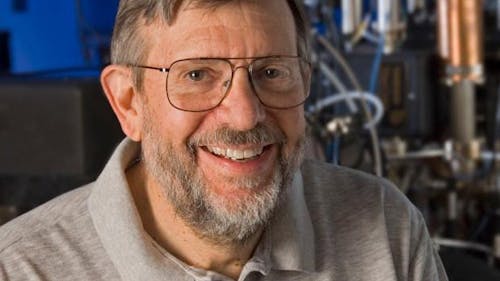Nobel Laureate explains physics concepts in 2016 Irons Lecture at Rutgers

Topics such as time, temperature and motion may seem very basic, but they have nuances and play important roles in extremely complex concepts and machines.
On Saturday, April 2, William Phillips, a physicist at the National Institute for Standards and Technology (NIST) and winner of the 1997 Nobel Prize in physics, gave the annual Henry R. and Gladys V. Irons Lecture in Physics and Astronomy on time and other physics concepts.
The Irons Lecture is an annual lecture held due to a donation by Rutgers alumnus Henry R. Irons, a former researcher for the U.S. Navy who helped invent a machine to measure the Earth’s magnetic field, according to the Rutgers Oral History Archives website.
Phillips began by describing some of Albert Einstein’s theories and predictions, such as the general theory of relativity and the photoelectric effect to the audience. The audience was composed of a wide range of people, from elementary school students to the elderly.
“(Einstein) asked himself the question ... ‘what is time?,'” he said. “For me, a clock is (that) something ticks, something that gives you a set of reproducible periodic results that allows you to tick off time.
Clocks using a pendulum were initially conceived by Galileo in the mid-17th century when he noticed the amount of time it took for a pendulum to move from one side to the other was constant, Phillips said.
Clocks, such as grandfather clocks, were designed using this mechanism. Eventually, mechanisms resembling a tuning fork were made with quartz crystals, giving extremely reliable results, he said. These mechanisms are used commonly for wristwatches.
Pendulums and quartz crystals are inaccurate for timekeeping due to their imperfections, which makes them unreliable, he said.
Atoms are used for extremely accurate timekeeping, as they are all identical to one another, so measuring time with one sample of atoms would yield the same results when measuring time with another sample of the same type of atoms, he said.
“Every quartz crystal is different from every other one,” he said. “Every cesium-133 atom is the same. I don’t mean almost the same, I mean exactly, indistinguishably the same.”
With quartz crystals, the time will need to be adjusted by about 30 seconds every year, whereas a cesium-133 atomic clock would need to be adjust 30 seconds every million years, he said.
This high level of accuracy comes with a high cost, as quartz crystal clocks can be purchased for less than $100, whereas cesium-133 clocks cost about $100,000, he said.
In Boulder, Colorado, NIST maintains an atomic clock that uses microwaves to change the phase of the excited cesium-133 atoms are moving in a long tube, and determined the time based on whether or not the phase changed, he said.
“The reason you (use a long tube) is you want a long time to measure it,” he said. “One of the problems is that these atoms are moving at over 100 meters per second, and the apparatus is only about 1 meter long, so you don’t have very long to measure it.”
Phillips then went on to explain methods of cooling down atoms to slow them down. He demonstrated these ideas through liquid nitrogen, the liquid form of the most abundant atom in the air, which is at about 77 Kelvin.
Phillips compressed many balloons into a bucket of liquid nitrogen, showing how their final volume was lower than their initial volume due to the low amount of energy in the air molecules.
He also soaked a racquetball and a rose in the liquid nitrogen, then crushed the frozen rose in his hand and shattered the racquetball as though it was made of porcelain. This showed how the atoms did not have the energy to adjust as they were moved, resulting in them shattering.
These cooled atoms would, over time, stick together or to the tube, so scientists had to devise a way to get them to remain in the same energy state without interacting with the tube. The answer was to use magnets so the atoms would repel from the container walls, he said.
Phillips demonstrated this by spinning a magnetic top over a plastic surface on a strong magnetic, pulling the surface up to the perfect height and finally removing the surface to show the top almost floating in mid-air.
By the end of the lecture, Phillips had described the concepts of time, energy, temperature, the process of laser-cooling and magnetism in an understandable way to a large public audience.
Harshel Patel is a School of Arts and Sciences sophomore majoring in molecular biology and biochemistry. He is the digital editor of The Daily Targum. He can be found on Twitter @harshel_p.



